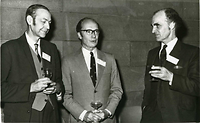


Developing dental education and research in Victoria
Introduction
Participants
Building a dental research culture
The influence of Frank Wilkinson
Developing linkages between the Dental School and Dental Hospital
The art and science of dentistry
The introduction and impact of fluoridation
Resolving a long-standing dispute with dental technicians
Training of dental health therapists
Dentistry's relationship with hospitals, government and industry
Controversy over the Dental School quota
The relationship between the School and the University of Melbourne
Relations between the School and the Australian Dental Association
The role of the School in childhood dental health
Funding research through the CRC and other programs
Personalities
Appendix; Some further thoughts stimulated by the Witness seminar
Endnotes
Index
Search
Help
Contact us

Mike Morgan: There are some common subjects. But the majority are not, and there are still quite clear distinctions between studies in medicine, dentistry, physiotherapy, nursing, behavioural science and other courses. So, no, I donít think thus far itís fulfilled that aim. The upcoming Melbourne Model[92] may change this situation.
Going back a little, when we merged, I thought there wasnít any choice. I thought the School had to become part of the larger Faculty.
Ann Westmore: What issues triggered the amalgamation of the Dental and Medical Faculties?
Henry Atkinson: Research was one. We had to front up for research [funding] and medicine didnít know what we were talking about. So we put the word, physiology, into one of our programs, and cleft palate into another, and these were words they seemed to understand. Peter had the advantage of a background in pathology and medicine. Otherwise it was difficult to get a dental subject across between gynaecology and ophthalmology and so on. We got our share.

Peter Reade: I think we were really pushed into it, werenít we? Some of us, at the time, hoped it would bring advantages, both in funding and in a general understanding of what we were trying to do.
Mike Morgan: There were advantages perceived in terms of protection. I donít think there were advantages in an academic or managerial sense.
Hector Orams: Is there much sharing of staff between medicine and dentistry, for example do some dentists demonstrate in anatomy and pathology?
Mike Morgan: No thereís not, Hec. It used to happen far more than it does now. Again, the Melbourne Model may provide a greater opportunity for improved mixing of staff.
Pat Storey: Tony was involved in [teaching] calcium metabolism [to medical students].
John Harcourt: The medical students donít do anatomy any more. (laughter)
 |
Witness to the History of Australian Medicine |  |
© The University of Melbourne 2005-16
Published by eScholarship Research Centre, using the Web Academic Resource Publisher
http://witness.esrc.unimelb.edu.au/115.html